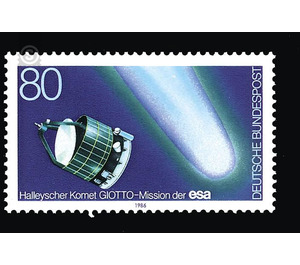Halley's Comet, GIOTTO mission of esa - Germany / Federal Republic of Germany 1986 - 80 Pfennig
Theme: Astronomy & Space
| Country | Germany / Federal Republic of Germany |
| Issue Date | 1986 |
| Face Value | 80.00 |
| Color | blue |
| Perforation | K 14 |
| Printing Type | 4-color rotogravure |
| Stamp Type | Postage stamp |
| Item Type | Stamp |
| Chronological Issue Number | 1146 |
| Chronological Chapter | GER-BRD |
| SID | 536746 |
| In 48 Wishlists | |
The occasion is the return of Halley's comet in its orbit around the Sun, which it approaches every 76 years, and the GIOTTO mission of "European Space Agency" (ESA). Edmond Halley, the well-known English astronomer, has discovered that the comets observed in 1531, 1607 and 1682 are in fact one and the same. Therefore, according to his own calculations in 1705, he was able to predict that this comet would return towards the end of 1758. He himself did not live to see his prediction come, but the famous comet has since borne his name. After the orbit of Halley's comet was known, one could also connect some spectacular comet phenomena in bygone times with him. The earliest "with certain certainty" demonstrable appearance of the comet goes to the year 240 BC. Back. The oldest depiction to date shows the comet in 1066, the year of the Battle of Hastings. The comet can be seen on the Bayeux rug embroidered a few years later, which tells the story of Norman conquest of England. On his return in 1301, he saw the Florentine painter Giotto di Bondone, who faithfully reproduced him in a fresco series in the Scrovegni Chapel in Padua. Halley's Comet served as the template for the Star of Bethlehem in the image "The Adoration of the Magi." Because this painting can be regarded as the first »scientific« description of the comet because of its realistic depiction, the European Space Agency ESA has given its comet probe the name »GIOTTO«. This mission is the first mission to become a comet and the first interplanetary mission for the European Space Agency at all. GIOTTO was launched on 2 July 1985 from Kourou, French Guiana, with an Ariane-1 rocket. After the launch, ESOC, the operations center of the ESA in Darmstadt, has taken control and control of the comet probe. ESOC is also responsible for retrieving and processing the scientific data received from GIOTTO. After a flight of 700 million kilometers, the GIOTTO comet probe will reach its target, Halley's Comet, on March 14, 1986 at 1:00 CET. One will try to pass the comet nucleus 500 km away on the sun facing side ("day side"). According to today's ideas, the core has a size of a few kilometers and consists of a mixture of ice (essentially water ice) and dust. When approaching the sun, the core heats up, the ice goes into the gas phase and thereby entrains the dust particles with it. This leads to the formation of a "comet atmosphere" or coma. Due to the radiation pressure of the sun, the gas and dust particles preferentially move in one direction from the coma and form the characteristic dust and gas branches. At the time of the flyby, the coma of Halley's comet has an extension of 400,000 km, while the two tails are many millions of kilometers long. The scientific objective of the GIOTTO mission was to find the cometary nucleus and to take color pictures of it with a resolution of 20 m, perform mass spectrometric analyzes of the dust and gas particles in the coma and the complex plasma-physical interactions between the solar wind and the cometary ionosphere investigate. For this purpose, GIOTTO carries a scientific payload of 10 experiments, which were provided by a large number of European institutes in collaboration. With the GIOTTO mission ESA builds on previous successes. To date, 13 scientific, 5 telecommunications and 2 meteorological satellites have been launched. 11 of these satellites are z. Z. still in operation. Added to this are the trials of the SPACELAB space laboratory and 12 successful launches with the ARIANE launcher. (Text: European Operations Center of the european space agency, esa, Darmstadt)


